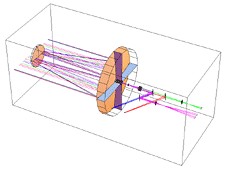
|
Optica Software bietet drei Zusatz-Produkte zu Mathematica: Rayica unterscheidet sich sehr von anderen Lösungen für optisches Design. Rayica baut zwar auf dem früheren Optica-Paket auf, aber bietet einen stark erweiterten Funktionsumfang. Rayica erlaubt geometrische, nichtsequentielle, Polariations Ray-Trace Berechnungen optischer Systeme im dreidimensionalen Raum. Optica3 enthält und erweitert Rayicas Funktionalität: symbolische Modellierung optischer Systeme, Diffraktion, Interferenz, Wellenfront und Gaussche Strahlfortpflanzung. Es produziert auch ausgezeichnete dynamische interaktive Grafik (wenn es zusammen mit Mathematica ab Version 6 eingesetzt wird), sowie CAD-Input für Ihre optischen Modelle. LensLab ist das Einstiegsprodukt von Optica Software. Das LensLab Paket enthält die Funktionen des früheren Optica und einige der Funktionen aus Rayica, aber das zu einem niedrigeren Preis als Rayica Optica Software Gründer und Entwickler Dr. Donald Barnhart demonstriert Optica 3 im Youtube Video: .Hier finden Sie mehr Informationen und Bildschirmfotos. Die Preise (auch die Preise für das Bildungswesen) erhalten Sie auf Anfrage. Eine graphische Tour durch Rayica | Rayica User Guide Eine graphische Tour durch Wavica | Wavica User Guide Übersicht über die Produkte in Form einer Power-Point Slide-Show Optica Newsletter Januar 2007 (pdf-Dokument) Optica Newsletter Januar 2008 (pdf-Dokument) Weitere Informationen finden Sie auf den Webseiten von Optica Software Bestellen Sie mit dem Bestellformular.
1 Coupled-wave theory used in certain calculations. |
||||||||||||||||||||||||||||||||||||||||||||||||||||||||||||||||||||||||||||||||||||||||||||||||||||||||||||||||||||||||||||||||||||||||||||||||||||||||||||||||||||||||||||||||||||||||||||||||||||||||||||||||||||||||||||||||||||||||||||||||||||||||||||||||||||||||||||||||||||||||||||||||||
|


